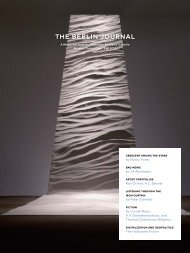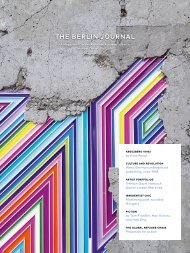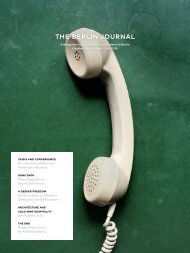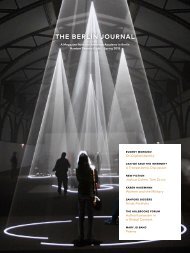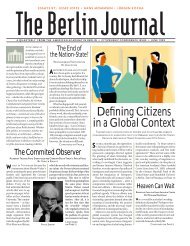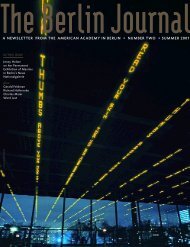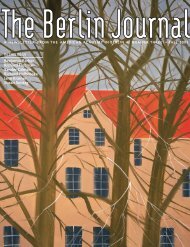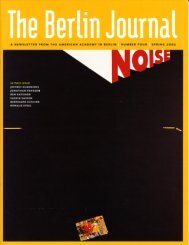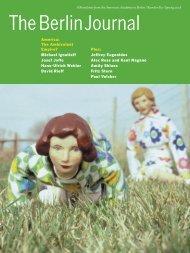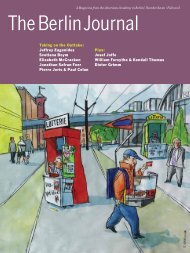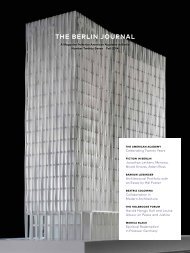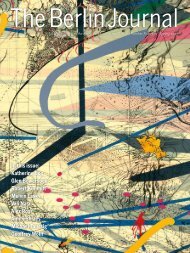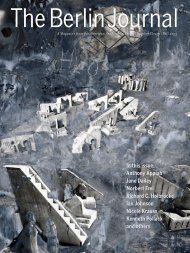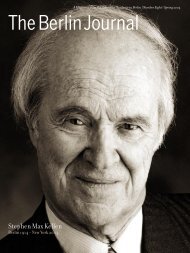Fall 2011 | Issue 21
- No tags were found...
You also want an ePaper? Increase the reach of your titles
YUMPU automatically turns print PDFs into web optimized ePapers that Google loves.
24 | The Berlin Journal | Number Twenty-One | <strong>Fall</strong> <strong>2011</strong><br />
Mirror suggested that the building “should<br />
be put in a museum to show how mad the<br />
Twentieth Century is.”<br />
Fifty years later the building had<br />
become the most iconic museum space in<br />
the world. To do justice to the architect’s<br />
vision, and the revolutionary impulse<br />
behind it, the museum’s board began having<br />
strange dreams. They wanted a show, a<br />
remarkable, epochal show, but one that did<br />
not obscure the architecture – one that, on<br />
the contrary, highlighted it. And yet the<br />
more mesmerizing the show, the more<br />
likely its images were to detract attention<br />
from the building. And so one day, during<br />
a meeting, a member of the board stood up<br />
and said, “Tino Seghal.”<br />
Seghal” is not a secret<br />
society of lovers. At least not yet.<br />
“Tino<br />
Tino is an artist and his materials<br />
– his marble and canvas, his paint and brass<br />
and bronze, his tempera and teflon – are<br />
people. In motion. What the Guggenheim’s<br />
board was proposing was to invite him to<br />
come do – something. A “staged situation.”<br />
After a good bit of closed-door discussion,<br />
they commissioned him to create a work<br />
that would highlight the building. He said<br />
yes and no. He said yes he would do it, but<br />
that no he would not give them any material,<br />
nothing that would remain after it was<br />
over. He would create a piece that would<br />
TINO IS AN ARTIST AND HIS<br />
MATERIALS – HIS MARBLE AND<br />
CANVAS, HIS PAINT AND BRASS<br />
AND BRONZE, HIS TEMPERA AND<br />
TEFLON – ARE PEOPLE. IN MOTION.<br />
leave the building’s gently curving walls<br />
blank, that would fill the museum with the<br />
curious and the caring, but there would<br />
be nothing left behind, no recording, no<br />
photographs, no catalogue, no advertising,<br />
no posters, no postcards, no premiere,<br />
no nothing. It would start and it would<br />
stop and that would be the end of it. The<br />
Guggenheim acquiesced. They drew up a<br />
contract which Tino would not sign, not<br />
because its conditions were unacceptable,<br />
but because even the material trace of a<br />
signature was more than he was willing to<br />
leave. The lawyers threw up their arms. A<br />
notary was summoned and the matter was<br />
concluded orally. The contract notarized,<br />
now all he needed was an idea – and three<br />
hundred hand-picked elements – that is,<br />
people.<br />
Some readers may have experienced<br />
the piece, and so are invited to<br />
skip the following section. For those<br />
who did not, here is the idea. You are in<br />
Central Park. You are walking north from<br />
the Protestant barn, walking south from<br />
your analyst’s office, walking east from<br />
Central Park, walking west from Petco. You<br />
see the Guggenheim, everyone sees the<br />
Guggenheim. Though you see no poster,<br />
no sign, have no sense of what is going on<br />
there, you come closer. You get in line. You<br />
wait, you ask questions, you get answers –<br />
many of which turn out to be wrong. You<br />
get to the front of the line. They say “One<br />
for this progress.” You say, “What?” They<br />
repeat themselves. You feel embarrassed.<br />
You think that you see some people kissing,<br />
slowly, languorously, on the floor in the<br />
central atrium. You say, “Yes.” You pay, you<br />
enter. You ask what you are supposed to do.<br />
You are told, “Just keep going up.”<br />
PROLOGUE: There is a indeed a couple<br />
kissing and hugging and holding and turning<br />
on the floor. At a radically reduced<br />
pace, every movement at the same slowed<br />
rhythm. It is beautiful. It is almost unbearably<br />
intimate. Their eyes are closed. Like a<br />
clearing in an enchanted forest there is an<br />
empty space around them. You watch for<br />
as long as you dare. You are lucky enough<br />
to witness an ending, and a beginning. The<br />
woman rises, slowly; turns, slowly; trails<br />
an arm behind her, slowly. He grasps it,<br />
holds it, and yet the force of her movement<br />
is too great, he is too far behind,<br />
and she, slowly, inevitably, moves away,<br />
the contact ending with the tips of their<br />
fingers. She walks slowly. He rises and<br />
follows. When they reach the ring of spectators,<br />
they disappear into it. And then a<br />
new couple arrives to take their place. The<br />
dynamic is different, sharper, somehow<br />
painful. You watch for as long as you can<br />
bear. Then you ask if this is it. You are told<br />
that it is not.<br />
ACT ONE: You walk up the first short<br />
stretch of ramp. From behind a low wall<br />
topped by a row of plants appears a child,<br />
from nowhere. From the greenery. Like<br />
in a fairy tale. The child says, “This is a<br />
piece by Tino Seghal.” She courteously<br />
asks if she can ask you a question. You<br />
say yes she can (who says no to a polite<br />
child emerging from the shrubbery of an<br />
iconic building?). She gestures for you to<br />
follow her into a room just off the ramp.<br />
She turns to face you. Her eyes are wide,<br />
earnest, those of a serious child. She asks,<br />
“What is progress?” She asks in a voice,<br />
and at an age, that the question feels real,<br />
genuine, answerable. So you tell her. You<br />
tell her what you think progress is. You<br />
avoid words like ideology and technocratic.<br />
You use ones like better, safer, kinder.<br />
ACT TWO: As you give your answer, a<br />
teenager, his whole unknowable hipster<br />
life before him, enters from the other side<br />
of the room. As soon as you finish, the<br />
child turns to the teenager and summarizes<br />
what she heard, interprets what you<br />
said. Her account will sound to you more<br />
and less right. You will want to correct or<br />
modify certain elements. But you won’t.<br />
The teenager motions for you to follow<br />
him out onto the ramp. He has the natural<br />
and not impolite arrogance of youth.<br />
You follow him into the stream of people<br />
moving upwards at various speeds. The<br />
walls are completely blank. The teenager<br />
says something about your vision of progress.<br />
You modify your answer. You use<br />
words like ideology and technocratic. You<br />
develop a rapport.<br />
ACT THREE: As you make your meandering<br />
way up the ramp, you are being<br />
observed. From above. You have already<br />
been identified, already been assigned.<br />
Someone is watching you carefully, albeit<br />
discretely. A half-revolution up the ramp<br />
she emerges from a concealed doorway,<br />
and begins to follow you. She is neither<br />
young nor old. She eavesdrops. At the next<br />
revolution of the ramp, she disappears<br />
without you having seen her, taking a<br />
shortcut upwards to lie in wait.<br />
ACT FOUR: You are making progress<br />
with the teenager, reaching an understanding,<br />
enjoying yourself, being clear<br />
and kind and even sort of wise. And then,<br />
out of nowhere, from an opening in the<br />
wall you did not see comes a question,<br />
abrupt, intriguing, unsettling. It reminds<br />
you of something, but you are not sure<br />
of what. It seems to have obliquely to<br />
do with what you said a while ago, but<br />
you are not sure. There is a lot going on.<br />
Uncertain about this new person, her<br />
bright eyes fixed on yours, you turn back<br />
to the teenager. He’s gone. Just gone. You<br />
turn around completely. He is still gone.<br />
This new person, who, after all, is friendly<br />
enough, has begun walking and you follow.<br />
She had asked you a question, the<br />
question obliquely relating to what you



